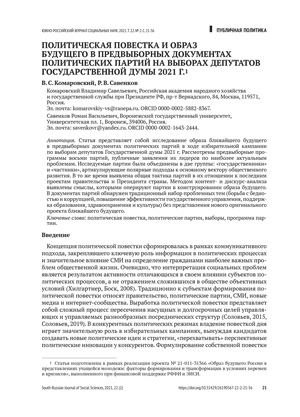Аннотация
Статья посвящена анализу цифрового вигилантизма (цифровой бдительности) как формы электронного гражданского участия в контексте проблем современного публичного управления. Цифровой вигилантизм является междисциплинарной проблемой, что подтверждают многочисленные зарубежные исследования, но для России этот термин нов. Политологический анализ позволяет авторам выявить двойственный характер вигилантизма, который является реакцией на неэффективность государственных институтов в условиях цифровых трансформаций и претендует на роль вспомогательного неформального института. С другой стороны, вигилантские сообщества могут оспаривать монополию государства на легальное насилие и провоцировать девиантное поведение в Сети. Новизна исследования состоит также в определении роли цифрового вигилантизма в процессе формирования публичных ценностей в контексте проблемы риска захвата сетевого гражданского общества. Авторы сфокусировали свое внимание на типичных дискурсивных практиках институционального (управляемого) вигилантизма среди известных российских вигилантских движений. В рамках исследования произведен сетевой анализ четырех сообществ русской социальной сети ВКонтакте: «СтопХам», «Лев Против», «Хрюши против» и «Антидилер». На основе анализа подписок аудиторий виртуальных сообществ выделен круг интересов «типичного вигиланта», сделан вывод о неполитическом характере движений. Однако агрессивные сетевые инициативы, претендующие на лидерство в формировании публичных ценностей, создают угрозы для устойчивого и динамичного развития гражданского общества в публичной сфере за счёт пропаганды «негражданского» характера общественной активности, тем самым нивелируя усилия по формированию общей цифровой среды доверия.
Ключевые слова
Информация о финансировании
Исследование выполнено при финансовой поддержке РФФИ-ЭИСИ в рамках научного проекта 21-011-31445 «Цифровой вигилантизм и практики формирования публичных ценностей: захват сетевого гражданского общества?»
Библиографические ссылки
Anderson, D. M. (2001). Vigilantes, Violence and the Politics of Public Order in Kenya. African Affairs, 101(405), 531–555.
Arellano, L. (2012). Vigilantes and Lynch Mobs: Narratives of Community and Nation. Temple University Press.
Arrobi, M. Z. (2018). Vigilantism as ‘Twilight Institution’: Islamic Vigilante Groups and the State in Post-Suharto Yogyakarta. PCD Journal, 6(2), 213–237. DOI: https://doi.org/10.22146/pcd.35215.
Bateson, R. (2021). The Politics of Vigilantism. Comparative Political Studies, 54(6), 923–955. DOI: 10.1177/0010414020957692
Brighenti, A. (2007). Visibility: A Category for the Social Sciences. Current Sociology, 55(3), 323–342.
Burrows, W. (1976). Vigilante. New York, NY: Harcourt Brace Jovanovich.
Chang, LYC, Poon, R. (2017) Internet Vigilantism: Attitudes and Experiences of University Students Toward Cyber Crowdsourcing in Hong Kong. International Journal of Offender Therapy and Comparative Criminology, 61(16), 912–932. DOI: 10.1177/0306624X16639037
Chernobrovkin, I. P., Shevelev, V. N. (2014). Vigilantizm v konfliktah mestnyh zhitelej i etnicheskih migrantov: upravlencheskij podhod [Vigilantism in The Conflicts of Local People and Ethnic Migrants: A Management Approach]. Social’no-gumanitarnye znaniya [Social and humanitarian knowledge], 11, 83–87.
Dennis, K. (2008). Keeping a Close Watch — The Rise of Self-Surveillance and the Threat of Digital Exposure. Sociological Review, 56(3), 347–357.
Douglas, D. (2016). Doxing: A Conceptual Analysis. Ethics and Information Technology, 18(3), 199–210.
Fuchs, C. (2015). Social Media and the Public Sphere. TripleC: Open Access Journal for a Global Sustainable Information Society, 12(1), 57–101.
Helmke, G., Levitsky, S. (2004). “Informal Institutions and Comparative Politics: A Research Agenda”. Perspectives on Politics, 2(4), 725–740.
Lund, C. (2006). Twilight Institutions: Public Authority and Local Politics in Africa. Development and Change, 37(4), 685–705.
Mclure, H. (2000). The Wild, Wild Web: The Mythic American West and the Electronic Frontier. The Western Historical Quarterly, 31, 457–476.
Meagher, K. (2007). Hijacking Civil Society: The Inside Story of the Bakassi Boys Vigilante Group of South-Eastern Nigeria. Journal of Modern African Studies, 45(1), 89–115.
Miroshnichenko, I. V., Morozova, E. V. (2017). Setevaya publichnaya politika: kontury’ predmetnogo polya [Network Public Policy: Outlines of Subject Field]. Polis. Politicheskie issledovaniya [Polis. Political Studies], 2, 82–102
Miroshnichenko, I. V., Ryabchenko, N. A., Yachmennik, K. V. (2017). “Novy’ye” setevy’ye aktory’ razvitiya lokal`noy politiki v usloviyaxkh sovremennoy Rossii [“New Network Actors of Local Policy in Contemporary Russia]. Vestnik Permskogo universiteta. Seriya: Politologiya [Bulletin of Perm University. Political Science], 1, 150–163.
Nivette, A. E. (2016). Institutional Ineffectiveness, Illegitimacy, and Public Support for Vigilantism in Latin America. Criminology, 54, 142–175. DOI: https://doi.org/10.1111/1745–9125.12099.
Obert, J., Mattiacci, E. (2018). Keeping Vigil: The Emergence of Vigilance Committees in Pre-Civil War America. Perspectives on Politics, 16(3), 600–661.
Rosenbaum, H. J., Sederburg, P. C. (1974). Vigilantism: An Analysis of Establishment Violence. Comparative Politics, 6(4), 541–570.
Schuberth, M. (2013). Challenging the Weak States Hypothesis: Vigilantism in South Africa and Brazil. Journal of Peace, Conflict & Development, 20, 38–51.
Shukan, I. (2019). Defending Ukraine at the Rear of the Armed Conflict in Donbas: Wartime Vigilantism in Odessa (2014–2018). Laboratorium: Russian Review of Social Research, 3, 71–104.
Simonova, I. A., Porozov, R. Y. (2019) Molodezhnyy vandalizm kak vigilantizm: rossiyskaya spetsifika “strategii bditel’nosti” [Youth Vandalism as Vigilantism: Russian Specificity of “Vigilance Strategies”]. Evrazijskiy yuridicheskiy zhurnal [Eurasian Law Journal], 10, 467–469.
Skoric, M. M., Wong, K.H., Chua, J.P.E. et al. (2010). Online Shaming in the Asian Context: Community Empowerment or Civic Vigilantism? Surveillance and Society, 8(2), 181–199.
Smith, N. R. (2019). Contradictions of Democracy: Vigilantism and Rights in Post-Apartheid South Africa. Oxford University Press.
Smorgunov, L.V. (2020). Instituty dostupnosti cifrovykh platform [Digital Platform Accessibility Institutions]. Yuzhno-rossijskiy zhurnal social’nyh nauk [South-Russian Journal of Social Sciences], 21(3), 6–19.
Stan, L. (2011). Vigilante Justice in Post-communist Europe. Communist and Post-Communist Studies, 44(4), 319–327.
Tanner, S., Campana A. (2019). “Watchful citizens” and Digital Vigilantism: A Case Study of the far Right in Quebec. Global Crime, 21(3–4). DOI: 10.1080/17440572.2019.1609177.
Trottier, D. (2017). Digital Vigilantism as Weaponisation of Visibility. Philosophy & Technology, 30(1), 55–72.
Trottier, D. (2019) Denunciation and Doxing: Towards a Conceptual Model of Digital Vigilantism. Global Crime, 21(1), 1–17 DOI: 10.1080/17440572.2019.1591952
Trottier, D. (2018). Revisiting Privacy in Public Spaces in the Context of Digital Vigilantism. Surveillance, Privacy and Public Space. Taylor and Francis.
Volkova, А., Lukyanova, G. (2020). Communication Strategies of Digital Vigilantes: in Search of Justice. IEEE Communication Strategies in Digital Society Seminar (ComSDS). DOI: 10.1109/ComSDS49898.2020.9101239
Wilkinson, D. L., Chauncey, C. B., Regina, M. L. (2009). Youth Violence Crime or Self-help? Marginalized Urban Males’ Perspectives on the Limited Efficacy of the Criminal Justice System to Stop Youth Violence. The ANNALS of the American Academy of Political and Social Science, 623, 25–38.
Zizumbo-Colunga, D. (2017). Community, Authorities, and Support for Vigilantism: Experimental Evidence. Political Behavior, 39(4), 989–1015.


